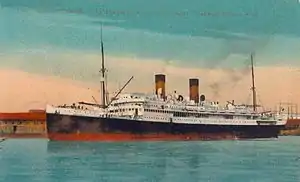SS Espagne (Provence, 1909)
Espagne was an 11,155 GRT ocean liner which was built in 1909 for Compagnie Générale Transatlantique. She served as a troopship during World War I and was in service until 1932, and was scrapped in 1934.
 Espagne | |
| History | |
|---|---|
| Name: | Espagne |
| Namesake: | Spain |
| Owner: | Compagnie Générale Transatlantique |
| Port of registry: |
|
| Builder: | Chantiers & Ateliers de Provence |
| Launched: | 1909 |
| In service: | October 1910 |
| Out of service: | June 1932 |
| Identification: |
|
| Fate: | Scrapped February 1934 |
| General characteristics | |
| Class and type: | Ocean liner |
| Displacement: | 11,155 GRT, 5,659 NRT, 4,467 DWT |
| Length: | 537 feet 8 inches (163.88 m) |
| Beam: | 60 feet 8 inches (18.49 m) |
| Depth: | 39 feet 0 inches (11.89 m) |
| Installed power: | Two 4-cylinder triple expansion steam engines, 1,376 NHP |
| Propulsion: | Twin screw propellers |
| Speed: | 18 knots (33 km/h) |
Design
Espagne was built in 1909 by Chantiers & Ateliers de Provence, Port de Bouc, Bouches-du-Rhône for Compagnie Générale Transatlantique.[1] She was 537 feet 8 inches (163.88 m) long, with a beam of 60 feet 8 inches (18.49 m) and a depth of 39 feet 0 inches (11.89 m). She was assessed at 11,155 GRT, 5,659 NRT,[2] 4,467 DWT.[1] The ship was powered by two 4-cylinder triple expansion steam engines. The engines had cylinders of 331⁄2 inches (85 cm), 5315⁄16 inches (137 cm) and two of 6613⁄16 inches (170 cm) diameter by 59 inches (150 cm) stroke. The engine was built by Chantiers & Ateliers de Provence.[1][2] Rated at 1,376 NHP, they could propel the ship at 18 knots (33 km/h) with her twin screw propellers.[1]
History
Espagne was the only transatlantic ocean liner built by Chantiers & Ateliers de Provence. Launched in 1909, she was completed in October 1910.[1] Her port of registry was Le Havre and the Code Letters OGPR were allocated.[2]
Espagne served on routes to Central America and the West Indies.[1] In April 1911, she was chartered as a troopship along with Aquitaine and Moulouya to transport 2,700 troops from Marseille, France, Algiers, Bône and Philippeville, Algeria to Constantinople, Ottoman Empire.[3] In September 1911, she developed a leak on arrival at Santander, Spain and was taken to Le Havre for repairs. In mid-1912, she was used on the Le Havre – New York route.[1] Following the Tampico Affair, Espagne transported 100 refugees from Puerto Mexico to Veracruz, Mexico.[4]
Espagne returned to the Le Havre – New York route from mid-1914. She transferred to the Bordeaux – New York route in 1915.[1] In February 1916, American passengers booked to travel on Espagne received anonymous letters telling them not to.[5] From 1916–20, she served as a troopship. Espagne returned to the Central American and Caribbean routes in 1920.[1] In 1926, a decree was issued in Mexico that all priests had to be born there. A number of Spanish priests were arrested and deported. Fourteen of them travelled on Espagne from Veracruz to a Spanish port in February 1926.[6] On 20 August 1926, she struck a rock off A Coruña, Spain and damaged one of her propellers.[7] Espagne served until June 1932,[8] when she was laid up. She was scrapped at Saint-Nazaire, Loire-Atlantique in February 1934,[9] by the company M. Glotz.[10]
References
- "liner ESPAGNE". French Lines. Retrieved 10 May 2014.
- Lloyd's Register. "LLOYD'S REGISTER, STEAMERS & MOTORSHIPS" (PDF). Plimsoll Ship Data. Retrieved 10 May 2014.
- "TROOPS FOR CASABLANCA". The Times (39565). London. 21 April 1911. col B, p. 6.
- "HUERTA's WAR REGIME". The Times (40552). London. 13 May 1914. col D, p. 7.
- "IMPERIAL AND FOREIGN NEWS ITEMS". The Times (41097). London. 23 February 1916. col D, p. 7.
- "PRIESTS DEPORTED FROM MEXICO". The Times (44197). London. 16 February 1926. p. 13.
- "Telegrams in Brief". The Times (44361). London. 27 August 1926. col G, p. 9.
- "MOVEMENTS OF LINERS". The Times (46155). London. 9 June 1932. col G, p. 22.
- "paquebot ESPAGNE" (in French). French Lines. Archived from the original on 2 May 2013. Retrieved 11 May 2014.
- "Espagne (5607826)". Miramar Ship Index. Retrieved 13 May 2014.